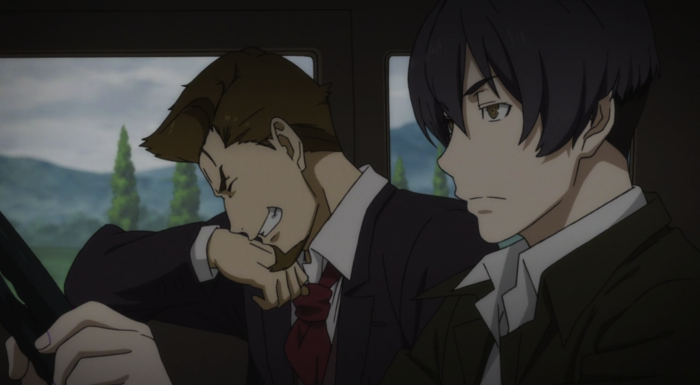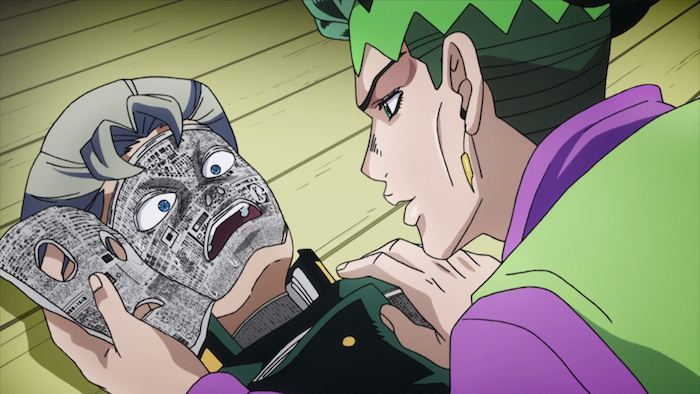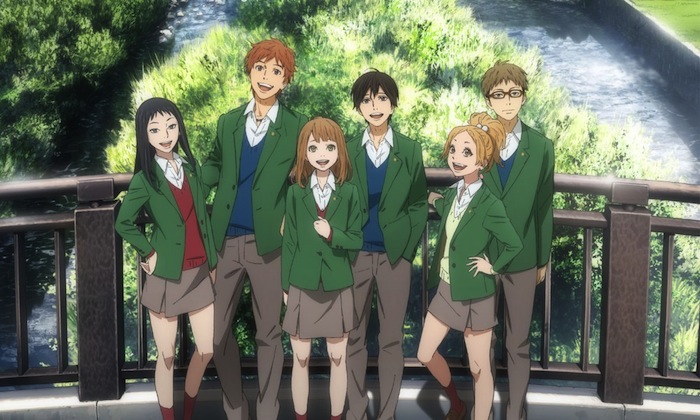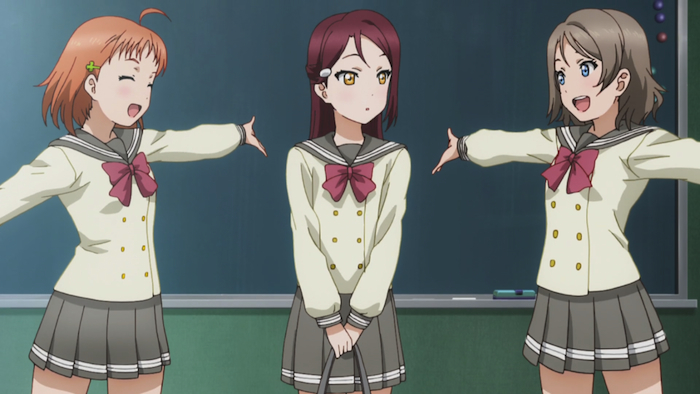Here is the rest of my list of “what to watch in the summer anime season,” with more long-winded explanations for each of them! The previous post is here.
#5 Love Live Sunshine!
I should start this out by admitting that I am a Love Live virgin. I have no previous experience with the franchise, except for a few attempts at the mobile game. So I can honestly say that you don’t need previous exposure to enjoy Love Live Sunshine!, which follows a completely different group of girls from the previous series. You don’t need to know much about it except the premise and that the last series’ idol group was called µ’s (pronounced like “muse”). The new crop are admirers of the old one, with their own personalities and reasons for wanting to be school idols.
“Cute girls in a school club” anime are not really My Thing, so I should explain why I find Love Live so compelling. The first reason is the sheer amount of energy on display in every single episode. This isn’t sleepy, “healing” moe fare: Love Live is excited about idols and wants to make sure that you are, too. Its conflicts are all small stakes, always revolving around Aquors, the new series’ idol group, but they treat every single one like it’s a big deal. Love Live passionately demands your attention at every moment, so you can’t help but be taken in by it.
The other reason is just how good this show looks. Like its predecessor, Love Live Sunshine! has great art and animation. It makes everything feel shinier and more inviting, like you just want to get lost in its happy world. The seaside setting for this particular incarnation of the franchise just adds to this effect. Love Live Sunshine! puts a lot of its out-of-school scenes on or near the beach, making every visit to its world feel like a summer vacation.
I also think, for me, there’s something very familiar and nostalgic about idol shows, with the conflicts so similar to the old-school Hollywood backstage musicals I grew up watching. Maybe I should watch more of them. If they’re as good as this one, I think I’ll have a lot of fun.
Current Episode Count: 5/13. Streaming Saturdays on Funimation.

#4 Thunderbolt Fantasy
So this one isn’t technically an anime, but how could I not include it on this list? Thunderbolt Fantasy comes from the twisted, fascinating brain of Gen Urobuchi, of Madoka Magica, Fate/Zero and Psycho-Pass fame. For real this time: this is not a drill, this is not one where he’s just listed under “story concept,” he’s actually writing the thing. Crunchyroll even has a preview episode that discusses the conception and technical details of the series’ production: Urobuchi went to Taiwan and saw the puppet theater troupe that moves the characters in this show. He loved it, and wanted to make the art form popular in Japan, and so here we are.
Thunderbolt Fantasy is basically wuxia, a type of historical drama that’s China’s version of our lords-and-ladies medieval fantasy. The plot is a fairly straightforward version of the genre, but where Urobuchi sells it is by turning the camp up to 11. Thunderbolt Fantasy knows the whole idea of “puppet TV” is kind of silly, and what’s more, the puppets need exaggerated movements and speech in order to fully come off as “human.” It gives it a really strong charm that helps to sell the silliness of the plot.
It’s hard to tell yet if Thunderbolt Fantasy will show any of the same moral dilemmas or character archetypes that are familiar from his other series. But it’s definitely fun, and hopefully leads to a whole new trend of campy puppet shows from other anime auteurs.
Current Episode Count: 4/13. Streaming Fridays on Crunchyroll.

#3 91 Days
91 Days is a pretty basic story: set in the Prohibition era in the United States, a young man returns to the town where he grew up on a mission. The mob killed his entire family except for him ten years ago. Now, he wants his revenge, and will do whatever it takes to get it–even if he has to compromise his remaining humanity for it.
There are so many stories like this in anime, and so many in the “gangster” genre worldwide. I think what makes 91 Days stand out from other “gangster” anime, such as Baccano! and, well, Gangsta, is how much it’s in dialogue with the previous works in that genre. It’s not just the obvious visual reference to The Godfather films in the series’ logo or in events like structuring a key plot point around a mob boss’s daughter’s wedding, but arguably the whole thematic struggle of how the bonds that make us most human can lead us to actions that deprive us of our humanity. So many mafia stories are rooted in the fact that people do these awful, bloody things for family.
91 Days is also indebted to film depictions of rural early 20th-century America, especially road movies. It’s an interesting mix of genres, along with the character focus and more drawn-out, breathable story typical of anime TV series. There is a lot more that I can say on this point, but I want to write a longer post about this series, so I’ll leave it there.
Oh, and it easily has the best soundtrack of this season, or at least tied with my next choice. That’s enough reason alone to check out this anime riff on a very American genre.
Current Episode Count: 4/13. Streaming Fridays on Crunchyroll.

#2 Jojo’s Bizarre Adventure: Diamond is Unbreakable
This is the one exception to the “get in now so you can catch up to it” rule: the current Jojo’s is now 18 episodes strong, and it relies on a lot of references to the previous arc at first. You can’t really go into Diamond is Unbreakable blind. It’s very well-worth the engagement, though, because Jojo’s continues to be excellent, in a way completely different from the series that came before it.
Jojo’s Bizarre Adventure always involved some epic good-vs-evil battle, even if it played out in different ways across those first three arcs. Diamond is Unbreakable starts that way, but as former enemies turn to Josuke and Koichi’s side, it’s becoming clear what the point of the series really is: suburban teens goofing off, but with superpowers. And because it’s Jojo’s, and it’s goofy and over-the-top and also has top-notch production values, it’s strongly compelling. It might just be my favorite Jojo’s arc, and not just because it’s doing a great job with the sort of stories I tried and failed at as a teenager. I think it gets at a really tonally accurate depiction of suburban life, in a way all the moodier ’90s fare about it that I think the show is building off of didn’t. It’s not that bad, but it’s not that great, either. It’s mostly just weird, and also kind of boring unless you try to have fun with it. A lot of being a suburban teen is finding ways to have fun with it.
Diamond is Unbreakable is basically the version of suburbia that suburban teens wish it was: all the creature comforts but with just a little more excitement to them, to spice them up.
Also, the Stands are amazingly weird, as the picture shows. Rohan is a great addition to the group, a manga artist who lives pretty much purely for his craft, constantly in search of more story material and not caring who he has to cross to get it. Of course, he has a stand perfect for it, that just reflects how much more interesting the Stands are getting as Jojo’s moves further and further away from the theme-based “logic” of the Stardust Crusaders ones. The sky is the limit now, and anything goes. And against the mundane suburban setting, it just makes the weirdness all the more pronounced.
I haven’t read the manga, so I have no idea where the show is going with this. But I don’t care if it’s building to an epic confrontation with a Big Bad, or if it’s just another season and a half of Josuke, Okuyasu, Koichi and Rohan finding goofy ways to entertain themselves in Morioh. Either way, I’m game.
Current Episode Count: 18/39. Streaming Fridays on Crunchyroll.

#1 Orange
Yep, the atmospheric teenage melodrama about suicide, romance and time-travel is my no. 1 pick for the season, surpassing even the inimitable Jojo.
I am also planning to write a longer post (or set of posts) about Orange, so I don’t want to use this section to spoil too much of that. But I think I should go into detail a bit about why this show wows me so much, because this genre isn’t usually the sort of thing that blows me away to the extent this series has.
Orange is just really good at capturing the emotions and high-stakes of adolescence. Something like Mob Psycho 100 tells, but Orange shows. It manages to find the perfect middle-ground between the extremes that anime usually goes to in depicting adolescence. It’s never too over-the-top or too subdued to be unrealistic. Not that there is anything wrong with either of those approaches, but it makes something that reaches for the perfect, most accurate middle feel refreshing.
I don’t think I’ve experienced an anime series that really got the emotional roller-coaster of adolescence since Paradise Kiss and Beck: Mongolian Chop Squad. Osamu Kobayashi was really good at that, in fact. Until he’s directing series again, we’ll always have Orange.
Current Episode Count: 5/13. Streaming Sundays on Crunchyroll.
